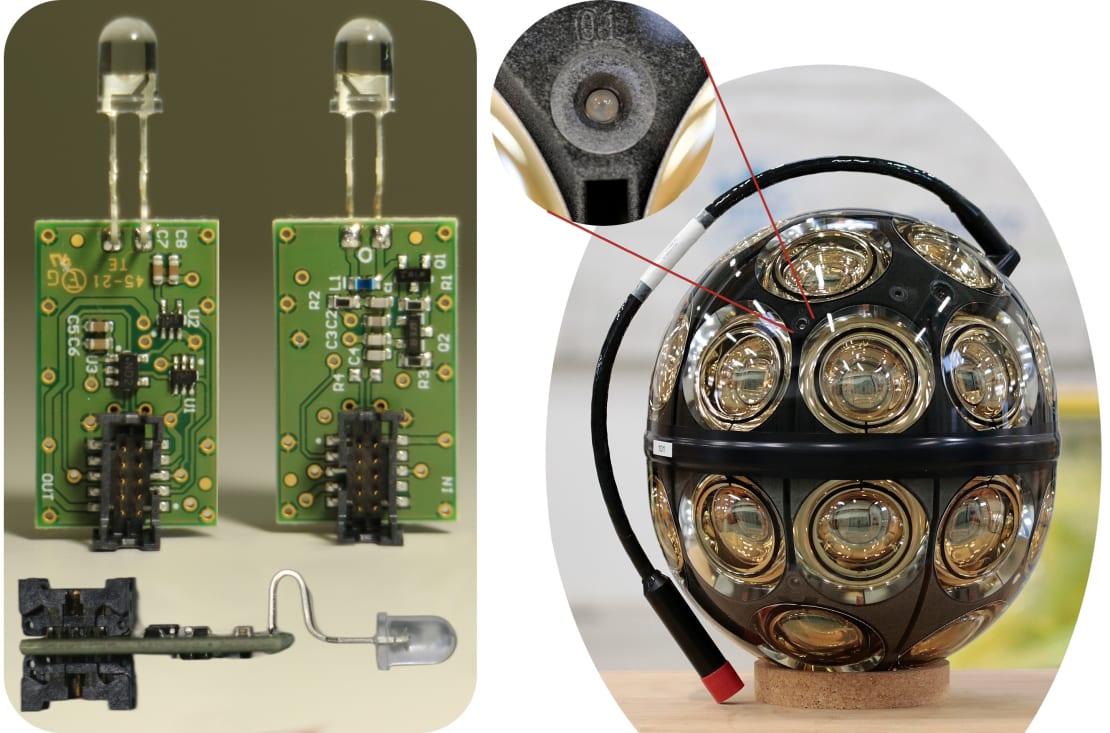Neutrinos are weakly interacting particles that are able to travel unhindered through the cosmos. When a neutrino interacts with a molecule in the ice, blue light is emitted from the resulting secondary charged particles through a process called Cherenkov radiation. The IceCube Neutrino Observatory at the South Pole consists of an array of 5,160 optical sensors embedded in ice that capture these faint light signals, allowing scientists to infer the energy and direction of neutrinos. This requires detailed knowledge about the optical properties of the instrumented ice.
An enhancement to IceCube, the ongoing IceCube Upgrade project will drill seven holes and deploy seven more closely spaced and more densely instrumented strings of optical sensors in the central part of the array this year during the 2025–2026 Antarctic summer season. One major goal for the Upgrade is improved calibration of the optical properties of the instrumented ice using LED flashers equipped to all sensor modules.
In a paper submitted to the Journal of Instrumentation, the IceCube Collaboration describes the design, mass production, and testing of the LED flashers for the IceCube Upgrade optical sensors: the multi-PMT digital optical module (mDOM) and the “Dual optical sensors in an Ellipsoid Glass for Gen2,” or (D-Egg). The performance for both types of optical sensors exceeded all of the design requirements.

The calibration of the instrumented ice is performed using light from LED flashers outfitted on all sensor modules, where light pulses with known intensity, position, orientation, and wavelength are emitted into the ice during dedicated calibration runs. Aside from dedicated calibration devices, the Upgrade strings will have both mDOMs and E-Eggs equipped with calibration LEDs similar to those used in IceCube.

“While we have recently made great strides in improving our knowledge of the ice, there is still a lot to be learned,” says Martin Rongen, a research associate at Friedrich-Alexander-Universität Erlangen-Nürnberg in Germany and study lead. “The Upgrade offers us a tremendous opportunity to improve our calibration and, therefore, our overall understanding of ice properties.”
Rongen was part of a team that produced and individually tested thousands of electronic boards, which required a lot of coordination between groups in Japan, Germany, and the U.S. This was necessary to ensure that the LED systems in the mDOMs and D-Eggs performed interchangeably and were tested to the same standards.
Production and testing of all LED flashers have now been completed and all LED modules incorporated into the D-Eggs and mDOMs. The sensor modules are set to be deployed during the 2025–26 austral summer season.
“Shortly after deployment we will commence operation of the flashers to test the instrumentation itself (the timing system and photomultiplier amplification) and then start data collection, which the next generations of ice models will be based on,” says Rongen.
+ info “The LED calibration systems for the mDOM and D-Egg sensor modules of the IceCube Upgrade,” IceCube Collaboration: R. Abbasi et al. Submitted to the Journal of Instrumentation. arxiv.org/abs/2508.03822